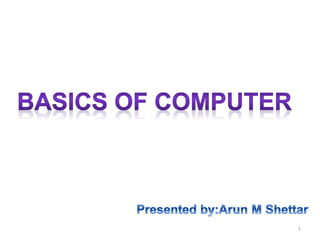
Basics of computer arun
- 1. 1
- 2. • A computer is an electronic device used for information processing. It accepts the data and instructions ,stores them in its memory, processes them and gives the results to the user. • The term ‘computer’ is derived from latin word ‘compute’ , which means to calculate or manipulate. Therefore , the computer is a calculating machine.
- 3. What is input device? The device which is used to input the data is called input device. Examples: Keyboard, mouse , joystick scanner. What is output device ? The device which is used to get the results is called output device. Examples: monitor, printer ,speaker ,plotter.
- 4. • Computer is a fast information- processing electronic device. It carries out all sorts of computations within a fraction of second. It executes millions of instructions per second • It gives accurate results for correct input data. If the input data is erroneous, then the output will not be correct.
- 5. • It gives consistent results, even though it is running on electrical connections and electronic circuits, which are prone to errors. • Its role is versatile. It is used for scientific calculations, business processing, computer games, teaching, training, music, fine art etc. • It does not feel tired. It can be used for hours. It can also be used non-stop for a number of days or months. It will work satisfactorily without fatigue.
- 6. Personal Computer Components A typical personal computer has components to display and print information (monitor and laser printer); input commands and data (keyboard and mouse); retrieve and store information (CD-ROM and disk drives); and communicate with other computers (modem). .
- 7. Printer (output) Monitor (output) Speaker (output) Scanner (input) Mouse (input)Keyboard (input) System unit (processor, memory…) Storage devices (CD-RW, Floppy, Hard disk, zip,…) Devices that comprise a computer system
- 8. What does a Computer Do? • Computers can perform four general operations, which comprise the information processing cycle. • Input • Process • Output • Storage
- 9. What are the Primary Components?
- 10. What are the Primary Components? • Input devices. • Central Processing Unit (containing the control unit and the arithmetic/logic unit). • Memory. • Output devices. • Storage devices.
- 11. What are the Primary Components? Input devices. • Keyboard. • Mouse
- 12. What are the Primary Components? Keyboard. • The most commonly used input device is the keyboard on which data is entered by manually keying in or typing certain keys. A keyboard typically has 101 or 105 keys.
- 13. What are the Primary Components? Keyboard.
- 14. What are the Primary Components? Mouse • Is a pointing device which is used to control the movement of a mouse pointer on the screen to make selections from the screen. A mouse has one to five buttons. The bottom of the mouse is flat and contains a mechanism that detects movement of the mouse.
- 15. What are the Primary Components? Mouse
- 16. What are the Primary Components? The Central Processing Unit • The central processing unit (CPU) contains electronic circuits that cause processing to occur. The CPU interprets instructions to the computer, performs the logical and arithmetic processing operations, and causes the input and output operations to occur. It is considered the “brain” of the computer.
- 17. What are the Primary Components? The Central Processing Unit
- 18. What are the Primary Components? Memory • Memory also called Random Access Memory or RAM (temporary memory) is the main memory of the computer. It consists of electronic components that store data including numbers, letters of the alphabet, graphics and sound. Any information stored in RAM is lost when the computer is turned off.
- 19. What are the Primary Components? Memory • Read Only Memory or ROM is memory that is etched on a chip that has start-up directions for your computer. It is permanent memory.
- 20. What are the Primary Components? Memory
- 21. What are the Primary Components? Memory
- 22. What are the Primary Components? Look inside your computer RAM BANK CPU
- 23. What are the Primary Components? Out Put Devices • Output devices make the information resulting from the processing available for use. The two output devices more commonly used are the printer and the computer screen. • The printer produces a hard copy of your output, and the computer screen produces a soft copy of your output.
- 24. What are the Primary Components? Out Put Devices
- 25. What are the Primary Components? Out Put Devices
